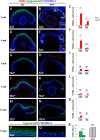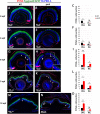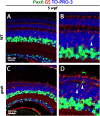TNFα Induces Müller Glia to Transition From Non-proliferative Gliosis to a Regenerative Response in Mutant Zebrafish Presenting Chronic Photoreceptor Degeneration
- PMID: 31998714
- PMCID: PMC6962764
- DOI: 10.3389/fcell.2019.00296
TNFα Induces Müller Glia to Transition From Non-proliferative Gliosis to a Regenerative Response in Mutant Zebrafish Presenting Chronic Photoreceptor Degeneration
Abstract
Unlike mammals, zebrafish have the capacity to regenerate neurons in response to damage. Most zebrafish retinal injury models employ acute damage, which is unlike the chronic, gradual damage that occurs in human retinal diseases. Here, we studied the regenerative response in the zebrafish aipl1b mutant, gold rush (gosh). In gosh mutants, both cones and rods degenerate by 3 weeks post-fertilization (wpf). Müller glia do not exhibit a regenerative response by 3 wpf; however, they do present non-proliferative gliosis. Only at 5 wpf, is proliferation of Müller cells and rod precursor cells activated. Rods start to recover at 5 wpf and by 12 wpf they reach a level of recovery comparable to wild type, but cones remain absent in the adult stage. TNFα was detected in degenerating cones at 5-7 wpf and in Müller glia at 7 wpf in gosh mutants. At 5 wpf, proliferating Müller glia express Sox2, followed by Pax6 expression in neuronal progenitor cells (NPCs), confirming that the neuronal regeneration program is activated in gosh mutants after 5 wpf. Although acute light-induced damage did not activate proliferation of Müller glia, TNFα injection caused Müller glia to commence a proliferative response at 3 wpf in gosh mutants. These results suggest that Müller glia transition from non-proliferative gliosis to a regenerative state in gosh mutants, and that ectopic introduction of TNFα promotes this Müller cell transition even at 3 wpf. Thus, zebrafish gosh mutants provide a useful model to investigate mechanisms underlying retinal regeneration in a chronic photoreceptor degeneration model.
Keywords: Aipl1; Müller glia; genetic mutant; photoreceptor degeneration; regeneration; rod precursors; zebrafish.
Copyright © 2019 Iribarne, Hyde and Masai.
Figures







Similar articles
-
Different inflammation responses modulate Müller glia proliferation in the acute or chronically damaged zebrafish retina.Front Cell Dev Biol. 2022 Aug 31;10:892271. doi: 10.3389/fcell.2022.892271. eCollection 2022. Front Cell Dev Biol. 2022. PMID: 36120571 Free PMC article.
-
Notch Inhibition Promotes Regeneration and Immunosuppression Supports Cone Survival in a Zebrafish Model of Inherited Retinal Dystrophy.J Neurosci. 2022 Jun 29;42(26):5144-5158. doi: 10.1523/JNEUROSCI.0244-22.2022. Epub 2022 Jun 7. J Neurosci. 2022. PMID: 35672150 Free PMC article.
-
Midkine-a Is Required for Cell Cycle Progression of Müller Glia during Neuronal Regeneration in the Vertebrate Retina.J Neurosci. 2020 Feb 5;40(6):1232-1247. doi: 10.1523/JNEUROSCI.1675-19.2019. Epub 2019 Dec 27. J Neurosci. 2020. PMID: 31882403 Free PMC article.
-
Retinal regeneration requires dynamic Notch signaling.Neural Regen Res. 2022 Jun;17(6):1199-1209. doi: 10.4103/1673-5374.327326. Neural Regen Res. 2022. PMID: 34782554 Free PMC article. Review.
-
Regulation of Müller glial dependent neuronal regeneration in the damaged adult zebrafish retina.Exp Eye Res. 2014 Jun;123:131-40. doi: 10.1016/j.exer.2013.07.012. Epub 2013 Jul 20. Exp Eye Res. 2014. PMID: 23880528 Free PMC article. Review.
Cited by
-
Advances in the study of Müller glia reprogramming in mammals.Front Cell Neurosci. 2023 Dec 14;17:1305896. doi: 10.3389/fncel.2023.1305896. eCollection 2023. Front Cell Neurosci. 2023. PMID: 38155865 Free PMC article. Review.
-
Heterogeneity in quiescent Müller glia in the uninjured zebrafish retina drive differential responses following photoreceptor ablation.Front Mol Neurosci. 2023 Jul 27;16:1087136. doi: 10.3389/fnmol.2023.1087136. eCollection 2023. Front Mol Neurosci. 2023. PMID: 37575968 Free PMC article.
-
Neural and Müller glial adaptation of the retina to photoreceptor degeneration.Neural Regen Res. 2023 Apr;18(4):701-707. doi: 10.4103/1673-5374.354511. Neural Regen Res. 2023. PMID: 36204825 Free PMC article. Review.
-
Clcf1/Crlf1a-mediated signaling is neuroprotective and required for Müller glia proliferation in the light-damaged zebrafish retina.Front Cell Dev Biol. 2023 Feb 10;11:1142586. doi: 10.3389/fcell.2023.1142586. eCollection 2023. Front Cell Dev Biol. 2023. PMID: 36846595 Free PMC article.
-
Reprogramming Müller Glia to Regenerate Retinal Neurons.Annu Rev Vis Sci. 2020 Sep 15;6:171-193. doi: 10.1146/annurev-vision-121219-081808. Epub 2020 Apr 28. Annu Rev Vis Sci. 2020. PMID: 32343929 Free PMC article. Review.
References
-
- Conner C., Ackerman K. M., Lahne M., Hobgood J. S., Hyde D. R. (2014). Repressing notch signaling and expressing TNFα are sufficient to mimic retinal regeneration by inducing Muller glial proliferation to generate committed progenitor cells. J. Neurosci. 34 14403–14419. 10.1523/JNEUROSCI.0498-14.2014 - DOI - PMC - PubMed
LinkOut - more resources
Full Text Sources
Molecular Biology Databases

